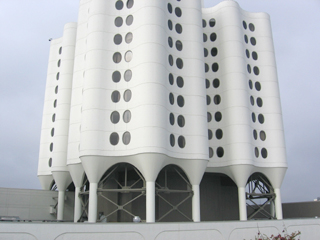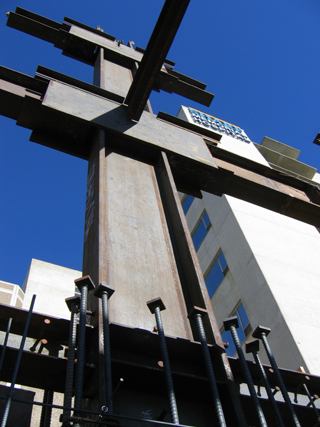
DJC.COM
April 24, 2008
Innovative structures help hospitals cut costs
ABKJ Consulting Civil and Structural Engineers

Shao
|
Innovation can provoke resistance. When a new structural idea is proposed for a building as complex as a modern health care facility, it must satisfy the interests of all the design team members involved, fulfilling their needs for a range of concerns such as schedule, appearance, cost impacts, functionality and constructability.
Teamwork is required to make an innovative idea into a reality. This was certainly the case when new seismic technologies and performance-based designs were introduced on several recent hospital projects.
From lab to job site
After the 1994 Northridge California earthquake, the steel industry was uncertain about how to handle steel moment frame connection design.
Rigorous limitations were imposed on what could be designed without project-specific testing. As a result, heavy steel columns weighing up to 730 pounds per foot were required for a new seven-story, 325,000-square-foot addition to the Sharp Memorial Hospital in San Diego.

Project team members had to be persuaded to install friction dampers in a seismic retrofit of the St. Joseph Medical Center Patient Tower in Tacoma. The project saved $1 million by foregoing more conventional techniques. |
After extensive engineering analyses and a thorough search of tested steel moment frame connections, engineers realized the column weight could be cut in half if a deeper column could qualify for the design. The emerging SidePlate proprietary moment framing connection had great potential if project-specific tests could be performed and qualified. The new design would also shave up to $1.8 million off the cost of the project.
The owner, contractor and architect agreed to carry out a testing program to qualify the connection. The design team worked with the Office of Statewide Health Planning and Development (the state agency in charge of all hospital design and construction in California) and successfully performed three full-scale tests in 2002 and 2003.
Sharp Memorial Hospital was the first facility to utilize this technology, and the tests enabled a design guideline to be developed that has been approved by OSHPD for all projects using this type of connection.
With the project near completion, the $1.8 million savings has been realized.
SidePlate in the Northwest

Photos courtesy of ABKJ Sharp Memorial Hospital in San Diego was the first building to use a new SidePlate moment framing connection, which eliminated the need for heavy steel columns. The structural design shaved $1.8 million off the project cost. |
In 2004, ABKJ brought the SidePlate technology to this region for the new five-story, 200,000-square-foot Overlake Hospital South Tower in Bellevue. The building is designed for five additional floors, allowing the owner to double the floor space in the future.
The building was completed last summer and the technology saved $1 million in construction costs.
ABKJ is currently using SidePlate technology on the eight-story, 340,000-square-foot Patient Care Tower for the $400 million Good Samaritan Hospital expansion project in Puyallup. Past successes made it easier to bring the owner, contractor and architect on board with this technology.
Performance-based design, in addition to prescriptive code-based design, was used to plan the new tower.
More and more hospital insurance providers require performance-based design and demand specific building seismic performances under different levels of seismic intensity. This requirement helps ensure that anticipated building performance levels can be achieved to reduce structural and non-structural damage during an extreme seismic event, and that the facilities will be operational under more frequent but less intense seismic events.
Friction damper savings
In performance-based design, it is not uncommon for higher performance levels to result in higher costs. Innovative technologies can counteract this.
When ABKJ was hired to help retrofit the St. Joseph Medical Center Patient Tower in Tacoma, the design used state-of-the-art seismic damper technology, saving $1 million by eliminating the foundation work with conventional retrofit techniques.
The friction damper is a device installed in a regular building seismic brace. It slips when the seismic forces in the brace exceed a predetermined force. The damper acts like a breaking pad in an automobile, reducing the amount of lateral sway. When the friction damper device slips, the friction forces still resist the seismic forces.
The existing St. Joseph building was designed and constructed in the 1970s. The tall, slender columns between the top of the building podium and the base of the tower created a “soft story” where excessive lateral displacements would occur during moderate seismic activity.
After various engineering approaches and cost comparisons, the approach of using friction dampers was implemented. It took many sessions between the owner, construction manger, architect and contractor to agree on the friction damper design approach. The retrofit was carried out successfully and the project was completed in 2006.
The committed contractor, open-minded construction manager and supportive architect made this cost-saving idea a reality. It takes great teamwork to deliver the savings that make a project a success.
Dihong Shao is a principal with ABKJ Civil and Structural Consulting Engineers and works on most of the firm’s health care facility projects.
Other Stories:
- Boomers lifting standards for patient care
- Architects play key role on health care team
- How BIM helped a hospital go green
- Time to improve hospital energy standards
- Boomers influence next generation of senior housing
- For patients, silence is golden
Copyright ©2009 Seattle Daily Journal and DJC.COM.
Comments? Questions? Contact us.